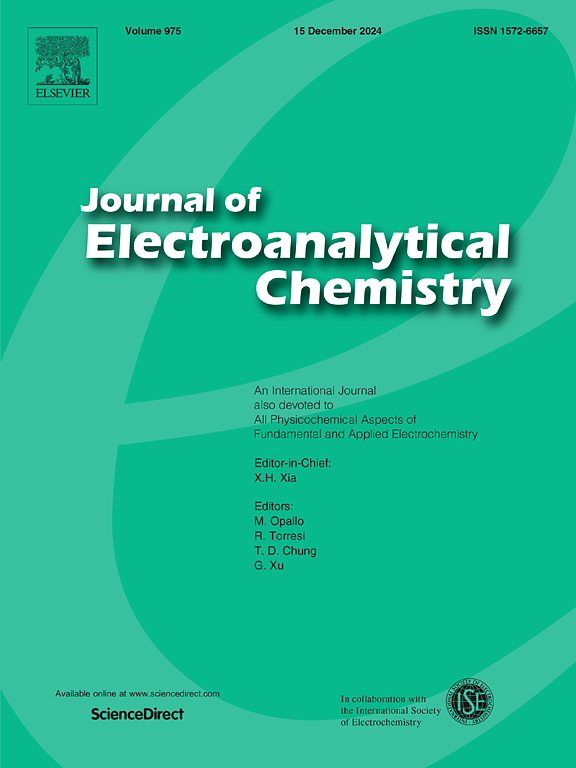用离子转移伏安法在极化水/有机溶剂界面研究了Na+、Cs+和Sr2+离子冠醚络合的溶剂效应
IF 4.1
3区 化学
Q1 CHEMISTRY, ANALYTICAL
引用次数: 0
摘要
利用本底电解质离子转移伏安法,完成了Na+、Cs+、Sr2+阳离子和Cl -阴离子从水中向苯腈(BN)、硝基苯(NB)、1,2-二氯乙烷(1,2- dce)和α,α,α-三氟甲苯(TFT)转移的标准吉布斯能值,以及所研究阳离子与二苯并-18-冠-6 (B218C6)的1:1或1:2冠醚配合物在溶剂中的稳定性常数。结果与现有文献数据一致,或符合先前报道的相关性。观察到对稳定常数有很强的溶剂效应,这被认为与水在特定溶剂中的溶解度有关,而不是目前关于供体数或溶剂的介电常数或离子的转移吉布斯能的解释。利用热力学循环计算了B218C6配合物从水中向BN、NB、1,2- dce或TFT转移的标准吉布斯能,并与现有伏安法测定的18C6配合物的转移吉布斯能进行了比较。B218C6和18C6配合物的转移吉布斯能之间约有20 kJ mol−1的显著差异,这可能与B218C6大环上存在两个芳环有关,令人惊讶的是,它们对离子或溶剂的性质并不十分敏感。本文章由计算机程序翻译,如有差异,请以英文原文为准。
Solvent effect on crown ether complexation of Na+, Cs+ and Sr2+ions investigated by ion transfer voltammetry at a polarized water/organic solvent interface
Ion transfer voltammetry of background electrolytes is used to complete the list of the values of the standard Gibbs energies of transfer of the Na+, Cs+ and Sr2+ cations and the Cl− anion from water to benzonitrile (BN), nitrobenzene (NB), 1,2-dichloroethane (1,2-DCE) and α,α,α-trifluorotoluene (TFT), and the stability constants of the 1:1 or 1:2 crown ether complexes of the studied cations with dibenzo-18-crown-6 (B218C6) in the solvent listed. The results agree well with the available literature data or fit in the correlations previously reported. A strong solvent effect on the stability constant is observed, which is proposed to be associated with the solubility of water in the particular solvent, in contrast to current explanations referring to the donor number or the dielectric permittivity of the solvent, or the transfer Gibbs energy of the ion. Standard Gibbs energies of transfer of the B218C6 complexes from water to BN, NB, 1,2-DCE or TFT are evaluated with the help of a thermodynamic cycle, and compared with the transfer Gibbs energies of the 18C6 complexes determined by the present voltammetric measurements. Remarkable differences of about 20 kJ mol−1 between the transfer Gibbs energies for the B218C6 and 18C6 complexes, which are probably connected with the presence of two aromatic rings on B218C6 macrocycle, are surprisingly not very sensitive to the nature of the ion or the solvent.
求助全文
通过发布文献求助,成功后即可免费获取论文全文。
去求助
来源期刊
CiteScore
7.80
自引率
6.70%
发文量
912
审稿时长
2.4 months
期刊介绍:
The Journal of Electroanalytical Chemistry is the foremost international journal devoted to the interdisciplinary subject of electrochemistry in all its aspects, theoretical as well as applied.
Electrochemistry is a wide ranging area that is in a state of continuous evolution. Rather than compiling a long list of topics covered by the Journal, the editors would like to draw particular attention to the key issues of novelty, topicality and quality. Papers should present new and interesting electrochemical science in a way that is accessible to the reader. The presentation and discussion should be at a level that is consistent with the international status of the Journal. Reports describing the application of well-established techniques to problems that are essentially technical will not be accepted. Similarly, papers that report observations but fail to provide adequate interpretation will be rejected by the Editors. Papers dealing with technical electrochemistry should be submitted to other specialist journals unless the authors can show that their work provides substantially new insights into electrochemical processes.

 求助内容:
求助内容: 应助结果提醒方式:
应助结果提醒方式:


